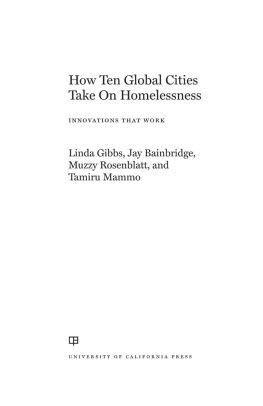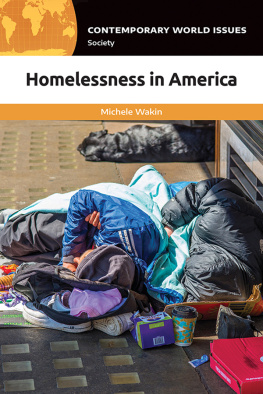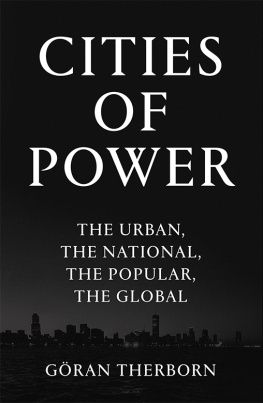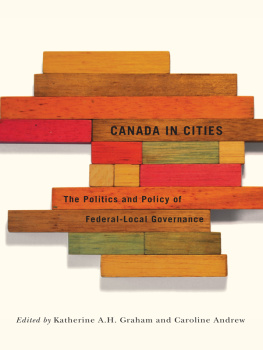How Ten Global Cities Take On Homelessness
PRAISE FOR How Ten Global Cities Take On Homelessness
Clear, comprehensive, and useful. This book mixes scholarly insights with practical knowledge.
Robert Doar, President, American Enterprise Institute
This book provides a comprehensive, well-documented approach to one of the worlds most significant problems from experts with broad experience.
Stephen Goldsmith, Harvard University
The publisher and the University of California Press Foundation gratefully acknowledge the generous support of the Lawrence Grauman, Jr. Fund.
University of California Press
Oakland, California
2021 by Linda Gibbs, Jay Bainbridge, Muzzy Rosenblatt, and Tamiru Mammo
Library of Congress Cataloging-in-Publication Data
Names: Gibbs, Linda, author. | Bainbridge, Jay, author. | Rosenblatt, Muzzy, author. | Mammo, Tamiru, author.
Title: How ten global cities take on homelessness : innovations that work / Linda Gibbs, Jay Bainbridge, Muzzy Rosenblatt, Tamiru Mammo.
Description: Oakland, California : University of California Press, [2021] | Includes bibliographical references and index.
Identifiers: LCCN 2020039066 (print) | LCCN 2020039067 (ebook) | ISBN 9780520344662 (hardback) | ISBN 9780520344679 (paperback) | ISBN 9780520975613 (ebook)
Subjects: LCSH : Homelessness.
Classification: LCC HV 4493 . G 43 2021 (print) | LCC HV 4493 (ebook) | DDC 362.5/92dc23
LC record available at https://lccn.loc.gov/2020039066
LC ebook record available at https://lccn.loc.gov/2020039067
Manufactured in the United States of America
25 24 23 22 21
10 9 8 7 6 5 4 3 2 1
Preface
This book is as much a beginning as a culmination, drawing from decades of experience that we, the authors, bring to the field of homelessness. We see possibilities of achieving goals that could not have been imagined even a decade ago. Our perspective has been amplified in recent years by engagements in cities on three continents of vastly different urban experiences. Patterns of urban migration, local economic conditions, and the rigor of social safety net services vary significantly. It is surprising, therefore, how strikingly similar the global challenges are of addressing the condition of street homelessness.
In the following pages, we set out a call to action. Urban streets littered with encampments of people sleeping rough has become something city dwellers everywhere simply accept. We have witnessed effective ways to coax these people off the streets and give them a chance for a better life. Despite frustrations, lack of resources, and a near impossibility of convincing some people who are sleeping rough to come inside, we have seen remarkable and lifesaving actions across many cities. The dedicated staff who work in outreach, shelter, and housing have inspired us with their unrelenting commitment to innovate and persevere until workable solutions are found for their clients. We believe these proven strategies can, and should, be replicated.
Even though we face difficulties and challenges, we still have hope. Each of us in our work has realized a piece of this hope.
Linda Gibbs served as the commissioner overseeing homelessness in New York City from 2002 through 2005, where she created the citys plan to reduce homelessness. She then served as New York Citys deputy mayor for health and human services from 2006 to 2013 before becoming principal for social services at Bloomberg Associates, a philanthropic, pro bono consultancy serving mayors in achieving their vision in meeting unique municipal challenges. Jay Bainbridge, an associate professor of public administration in the School of Management at Marist College, worked at the New York City Department of Homeless Services, where he helped develop the citys first homeless street count, and he continues to consult on homeless services policy and planning for national and international cities. Muzzy Rosenblatt is chief executive officer and president of Bowery Residents Committee (BRC), a nonprofit organization committed to bringing stability and dignity to nearly ten thousand homeless and at-risk individuals each year in New York City. Tamiru Mammo, after more than a decade working for New York City in the mayors office and as chief of staff at the largest municipal hospital system in the country, joined Bloomberg Associates as a manager of social services. In that role he has led comprehensive homeless reform efforts in Bogot, Mexico City, and Athens and has supported homeless program development in Paris, Nashville, and Baltimore.
When former New York City mayor Michael Bloomberg established Bloomberg Associates after he left City Hall in 2013, each of us was invited to join, in a full-time or consulting capacity. The idea was simpleleverage the knowledge of a group of leaders from the New York City government to help mayors of other cities nationally and internationally to tackle their complex issues. Doing this work pro bono, we provide hands-on guidance to help mayors focus on their challenges. In this way we closely witness the dynamics in cities as diverse as Paris and Baltimore, Bogot and Nashville. By far the most frequently requested strategic advice has to do with overcoming street homelessness. While the municipal leaders, nonprofits, advocates, communities, and resources involved are as varied as the people who are on the streets, the challenge is the same: persuading outreach, shelter, behavioral health services, and housing providers to coordinate their services in a way that reaches each person on the street, assesses their individual needs, and offers them safe shelter and stable housing that works for them.
The ten cities we discuss in this book differ greatly in the size and severity of their homeless populationsfrom Athens, with a total population of close to 700,000 and just 350 people on the streets, 200 in temporary social housing, and 200 in night shelters, to our hometown of New York City, with a population of 8 million and over 70,000 in shelters but just over 3,500 on the streets. The other citiesBaltimore, Bogot, Edmonton, Houston, Los Angeles, Mexico City, Nashville, and Parisvary in the scope of challenges they face and the level of their works sophistication. Some, like Athens, have no coordinated system and their work is driven largely by nonprofits. Edmonton approaches the homeless with coordinated entities that include public and private partners; while, in New York City, the municipality has to be reminded to make a space at the table for less powerful voices. Every city, however, uniformly brings talent, energy, and resources to pursuing its efforts with determination to withstand the setbacks and maintain momentum in a field that has few quick wins.
In August 2018 the four authors gathered with practitioners from the ten global cities in a weeklong peer-learning forum in the Rockefeller Foundations retreat space in the Italian town of Bellagio. Our goal was to plumb the groups collective knowledge. With so much experience shared, participants could both contribute and work through thorny issues plaguing their efforts. We workshopped our individual initiatives, refining theories of change and developing implementation strategies. Some ideas were dropped completely when they didnt survive the harsh questioning from battle-tough peers, while other new concepts spread by weeks end to colleague cities agendas. We also spent long hours over meals and late-night discussions, sharing our observations and frustrations about the overall environment. What makes one city so effective at keeping momentum going while other cities risk losing all progress when leadership changes or a crisis hits? The greatest successes were found where a combination was present of effective management, sufficient resources invested in evidence-based practices, and skilled leadership that rallied the troops through triumphs and failures.










